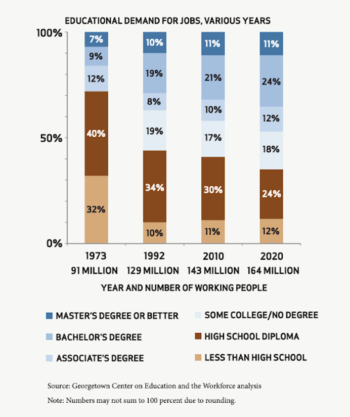Accelerate ED: Leading Students to Better Jobs

While the United States is more educated than ever, only approximately 25 percent of adults currently received a bachelor’s degree and about half an industry-recognized certification after high school.
The Georgetown University’s Center on Education and the Workforce reported that by 2020, 65 percent of all jobs in the economy were expected to require postsecondary education and training beyond high school.

The debate between college versus career has been front and center for students as they weigh their options for life after high school graduation. In today’s economy, with rising inflation, a “red hot” job market, and lingering impacts from the COVID-19 pandemic, more students are entering the workforce earlier than previous years and foregoing postsecondary education.
This is a dangerous trend. Given the direction of the labor market, it is very difficult to find long-term success and economic stability without some sort of postsecondary education or training. Students who go immediately into the workforce after high school without any additional training typically do not make enough money to sustain an individual or a family, adding to the persistence of systemic inequities.
At ESG, we are working with twelve design teams through the Accelerate ED initiative to increase educational opportunities and improve people’s economic future , specifically by creating and expanding 13th year models in which students can earn an associate degree within one year of high school graduation at little-to-no cost to them.
“This can really change the trajectory of students’ lives,” says Illinois design team member and Associate Superintendent for Teaching and Learning at High School District 214 Lazaro Lopez. “What it means is you’ve significantly increased their likelihood of not only graduating from college, but making well informed decisions about the next steps in their lives and where they can go where they can best, pursue whatever it is that they’re trying to pursue.”
Once students have completed their 13th year, they not only have credits toward a postsecondary degree, but they have invaluable postsecondary experience that they otherwise may not have had, often saving them time and money. Rather than spending unnecessary time selecting a field of study, students are exploring potential careers and gaining work-based learning experiences while in high school. Research on early college options, career technical education opportunities, and dual enrollment models—many of the strategies the Accelerate ED design teams are building into their work—shows strong evidence of impact on outcomes, including increases in high school graduation, college enrollment, and degree attainment. Dual enrollment students are more likely to finish high school, persist in postsecondary education, and accumulate college credits than students not participating in dual enrollment.
The Accelerate ED design teams are working to build stronger connections between education and the workforce, with an eye toward the economy of the future. Check out the video above to hear more about their work.



